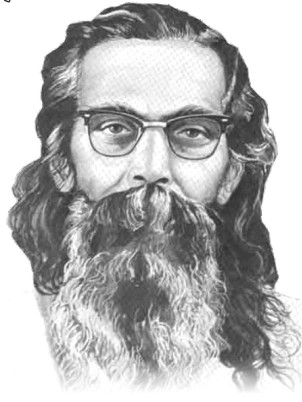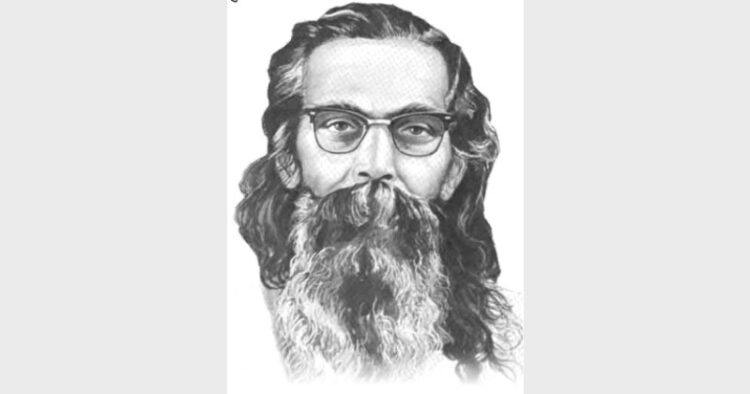 ISLAMIC Pakistan”s pre-Islamic past being a long one extending over five millennia – and dating back to Indus civilsation – the historical narrative in the establishment of Pakistan”s website too is long. The Pakistan narrative recalls the historic battle of Puru @ Purushottama [meaning Supreme Being] and Alexander. It says that Alexander “fought the greatest battle on the bank of the Jhelum river opposite the present village of Jalalpur Sharif against Porus, the head of the heroic Puru tribe”. It proudly proclaims that Porus” “descendents still supply military personal to the Pakistan army.” See where its claim about Puru tribe leads today”s Pakistan and fixes its ancestry.
ISLAMIC Pakistan”s pre-Islamic past being a long one extending over five millennia – and dating back to Indus civilsation – the historical narrative in the establishment of Pakistan”s website too is long. The Pakistan narrative recalls the historic battle of Puru @ Purushottama [meaning Supreme Being] and Alexander. It says that Alexander “fought the greatest battle on the bank of the Jhelum river opposite the present village of Jalalpur Sharif against Porus, the head of the heroic Puru tribe”. It proudly proclaims that Porus” “descendents still supply military personal to the Pakistan army.” See where its claim about Puru tribe leads today”s Pakistan and fixes its ancestry.
Who are Purus? They belonged to the tribe of Pauravas that descended from Purus who figure in the Rig Veda. [A History of India, By Hermann Kulke, Dietmar Rothermung, pp 57] According to wellknown historian DD Kosambi, the Purus were Aryans and closely related to the Bharatas, with whom they had monetary differences. The Purus remained in the Harappa region and expanded their rule over the Panjab later. It was the Purus, led by Purushottama, fought Alexander in 327 B.C. [Ancient India: A History of its Culture and Civilisation pp 81-83]. The Purus figure in the Battle of the Ten Kings (dasarajñá) in the Rig Veda. According to historians, in this battle between Aryans, Puru tribes guided by the royal sage Vishvamitra, fought the Bharata king Sudas guided by Vasishta, and lost. [Rig Veda 7.18] Buddha Prakash, Professor of History and of Ancient Indian History, Culture and Archaeology, Director of the Institute of Indic Studies (1964) says that thereafter, Purus merged with the Bharatas in Mathura. But, some of them remained in Punjab and probably survived as Puris, a Kshatriya sub-caste. [Political and Social Movement in Ancient Punjab. P77] Historians agree that the modern Punjabi name of Purus is Puri. Some historians also believe that Purus were Shoorsainis of Mathura whose ancestors were Krishna and Balarama. Another tradition links Purus to Lord Shiva. Purus are also linked to the Pandavas.
Arjuna, Vaisampayana, Janmejaya as Pakistan”s ancestors. Mahabharata as its heritage
Pakistan establishment”s website on its heritage carries ten long chapters on Taxila. The first chapter on “pre-historic Taxila” says that “the oldest rulers of Taxila were Takshakas”; their “modern descendents are the Taka tribe of Pakistan”; the “name Takshaka originated from worship of Takila, that is serpent”; even today the name continues in Persian as Maralla – Mar [serpent] and Q-ila[fort]. It says that Taxila is “on the bank of the river known as Tamra-nala, correctly Dharama-nala.”
Chapter II on Taxila of the Aryans says: “Aryans arrived in Taxila” around 1500 BC, “gave the regional name Gandhara” (meaning the land of fragrance), and ruled Taxila “until the time of the Indian epic Mahabharata.” “Gandhara gave the name” to “queen Gandhari of Mahabharata”. “One of the local Takshaka ruler bit (defeated) Parikshita, a grandson of the Mahabharata hero Arjuna, but his son Janmejaya routed the Takshakas and established his seat at Taxila on the top of Hathial Mound.” it adds, “Here on this site for the first time Mahabharata was recited by Vaisampayana to the king Janmejaya.”
Chapter III which celebrates Taxila University as the world”s first university lists Jotipala, [who later became the commander-in-chief of the Banaras King, Jivaa and the physician of the Magadhan ruler Bimbisara and of Buddha himself] the famous king Prasentajita of Kosala around modern Ayodhya and prince Chandragupta, founder of the Mauryan Empire as alumni of the university. Saying “[A]mong the teachers we have” it lists Panini, “the great grammarian” of 600 BC, Kautilya “the famous writer of the Arthashastra, a book on political science” and “the great physician” Charaka.
Chapter VI on the Taxila in Mauryan period says that several Mauryan princes were associated with Taxila. The second Mauryan emperor Bindusara sent Asoka twice to pacify the Taxilans. In the time of Asoka prince Kunala was appointed viceroy. Then followed Dasaratha and his son Samprati.
Chapter VIII on Taxila during Kushana period in 1st century AD, whose greatest emperor was Kanishka, says that Gandhara Art took its final form at the time of the “Great Kushanas”.
Chapters IX on Taxila of Huns and Turki Shahis and Chapter X on Taxila during Muslim rule talks about the decline and destruction of Taxila.
Kushana, not Islamic period as “Pakistan”s Golden Age’. Maharaja Ranjit Singh as “the most brilliant leader of Punjab”, not Gaznavi or any Moghul!
The Pakistani government narrative goes on the celebrate the Kushana Empire and says “Kushana emperors built a mighty empire with Peshawar as their capital, the boundaries of which extended from the Aral Sea to the Arabian Sea and from Afghanistan to the Bay of Bengal.” and says that “[T]he Kushanas period was the golden age of Pakistan”. The narrative adds, “Kushana kings who have gifted the national dress of shalwar and kamiz and sherwani to Pakistan”. On the Sikh rule over Pakistan, it says that the “Sikhs established their empire in Punjab after the death of the Mughal Emperor Aurangzeb in 1707 when the country descended to anarchy. Taking advantage of the situation, Charat Singh, who was the head of one of the Sikh clans, established his stronghold in Gujranwala in 1763. After him, his grandson, Maharaja Ranjit Singh, the narrative says, “the most brilliant and remarkable leader in the history of Punjab united the whole Punjab under one flag and ruled from the banks of the Jamuna to the Khyber and from Kashmir to Multan” for 40 years.
No claim of Turkish, Afghan or Moghul ancestry. No celebration of Islamic invaders. Islamic value addition limited to One God, architecture, food, dress and Urdu
A striking aspect of Pakistan establishment”s narrative of its history, heritage and culture is that it does not celebrate the Islamic invaders of Turk, Moghul or Afghan origin as its ancestors or heroes! The narrative talks of the entry of Islam and what it added to Pakistan thus:
On the advent of Islam in Pakistan, the Pakistan government says: “The light of Islam penetrated this part of the world as early as 712 from the West with the Arab General Mohammed bin Qasim and in the10th century from the north with Turk Mahmud Gaznavi.” On what Islam did to Pakistan, it says: “Islam replaced worshipping idols and introduced new philosophy of faith in one God.” On what Islam added to Pakistan, it says: (i) a new culture from Arabia and Central Asia; (ii) a new type of architecture that manifested in tens of thousands of mosques, tombs and gardens built by Muslim rulers; (iii) new variety of dishes to Pakistan”s cuisine; (iv) Shalwar Kamiz as new dress from Turkey; (v) new lauguage “Urdu”, now Pakistan”s official language. That is all and nothing more according to the official Pakistan government website, is the role and the contribution of Islam and Islamic rulers to Pakistan.
The official website [http://www.heritage.gov.pk/html_Pages/culture.heri.html] of Pakistan contains detailed description of the cultural heritage of Pakistan summarised briefly in the previous part and this part. To recapitulate, it owns Indus Civilisation, meditation, yoga, and serpent worship of that time as Paksitan”s heritage. Islamic Pakistan projects Vedic Aryans, and their Taxila kingdom and Taxila University, as part of its heritage. It proudly owns Hindu India”s ancestor Takshaka as the ancestor of today”s Pakistan”s Taka tribe. It owns the great warrior Puru and his tribe Purus as its ancestors proudly saying that the Purus still supply soldiers to its army. It displays Taxila University, Mahabharata as Pakistan”s heritage; projects Arjuna, Vaisampayana, Janmejaya, Charaka, Panini and Chanakya, its ancestors. It values Arthashastra of Chanakya as its heritage literature. It regards Chanakya, Chandragupta Maurya, Ashoka, Kushana kings, Takshakas, none of them have anything to do with Islam, yet Islamic Pakistan owns them as among Pakistan”s forefathers. Even Islamic Pakistan”s national dress is not Islamic but Kushan in its origin. So everything that Pakistan holds out to the world today as its heritage, and every historic personality it projects to the world as its forefathers are the common heritage of Hindus and Hindu converts who became Muslims. The narrative regards the culture and traditions of all Pakistan”s pre-historic, pre-Islamic, Islamic or post-Islamic predecessors – read ancestors — “as a treasure” which is “Pakistan”s national heritage.” This is an astounding U-turn for a nation that was formed by a separatist movement that had denied all this!
Pakistan’s new claim to Hindu cultural identity proves Guruji as a seer
The moment Muslims of Pakistan or Bharat look back and become conscious their history, tradition, and heritage how their entire perception would, as Guruji says, change. Like Pakistan proudly owns the pre-Islamic Hindu heritage by separately naming Takshaka, Aryan, and Buddhist streams of the Hindu culture, like Pakistan traces its Taka Muslims to Takshaka and Puru Muslims to Purus of Rig Veda, and like the ancestors of Puru Muslims of Pakistan are seen as Pandavas, Krishna, Balarama, Shiva, if the Indian Muslims are educated to own and become consciosus of their common ancestry with Hindus, how they would become one with the Hindu society, their religious identity regardless. How farsighted was Guruji when he said that ‘common ancestry’ as the ultimate identity and bond between Hindus and Muslims. He was clear that neither the religious identity of Pakistan, nor the Arabs, Turks or Afghani Muslims can define the ancestry of Muslims in Bharat, divided or undivided. Today”s Pakistan proves him right, and establishes him again as a seer.
And now the most important question. Why does the Pakistan establishment, the creation of the Muslim League which had denied all common legacy with Hindus and claimed exclusive, artificial, exclusive, even hostile Islamic heritage, now U-turn to celebrate the ancestors and heritage of Hindus as its own? And why do the Indian Muslims behave like the pre-Partition Muslim League and think unlike the Pakistan establishment of today? Answers will follow in parts that follow.













Comments